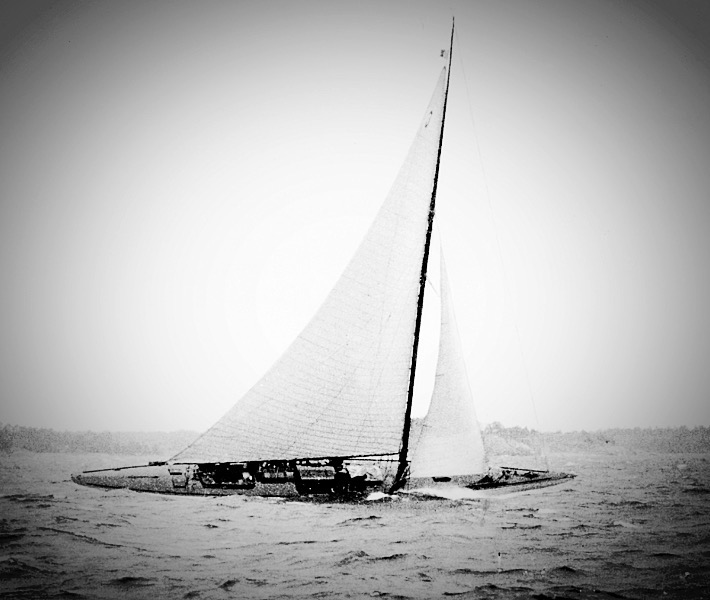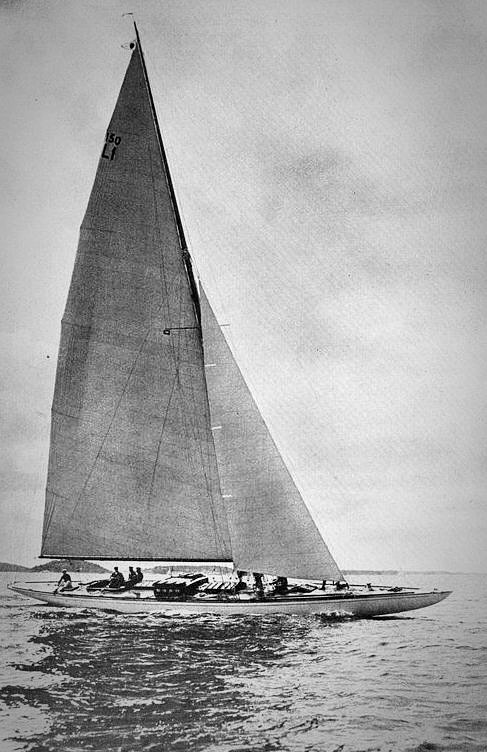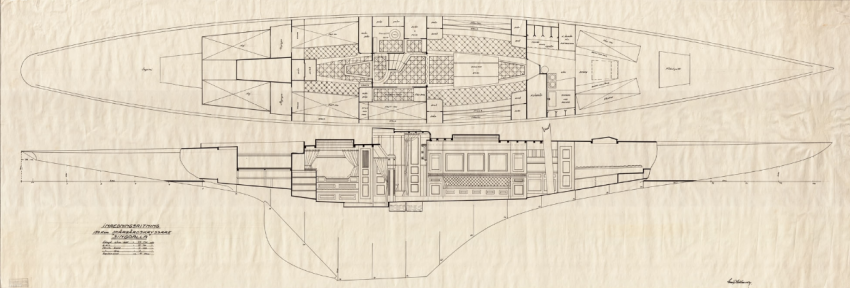
Sail Number: 150/6
Type: SK-150 (skärgårdskryssare)
LOA: 78′ 7″ / 23.94m – LOD: 78′ 7″ / 23.94m – LWL: 53’10” / 16.40m – Beam: 10′ 12″ / 3.35m – Draft: 9’11” / 3.00m – Displacement: 16 tons – Ballast: 8 tons – Hull material: Wood – Designer: Gustaf Estlander – Type: 150 kvm skärgårdskryssare – Built by: Hästholmsvarvet, Gåshaga on Lidingö. – Year Built: 1919 – Engine: – Sail Area: 150sqm – Flag: Sweden (SE) – Locator: Destroyed, shipyard fire 1923
Historical:
Singoalla, the largest and perhaps fastest of all archipelago cruisers. The impressive 150 m2 archipelago cruiser “Singoalla”, was designed by Gustaf Estlander, and built by the Hästholmsvarvet in 1919.

In 1918 Gustaf Estlander received an order for the largest class of archipelago cruiser, SK150, from Nils Österman who made a fortune during the economic 4 year boom of World War I. Singoalla was built at Hästholmsvarvet in Gåshaga on Lidingö, and delivered in 1919. Österman’s fortunes reversed and Gustaf Estlander takes possession of the newly built vessel and renames her – Singoalla. Unfortunately, she is too slightly built; blaming the shipyard and the rule she was built for. After reinforcement she successfully competes for the 1920–22 seasons, but is destroyed in a fire at a shipyard in Travemünde, Germany.
Search Magazine comments (searchmagazine.se)
Singoalla was extremely long – 24 meters and finished in 1919. She sailed faster than anyone else and then in 1923, she burned and nothing was left, which naturally led to speculation.
When a boat burns, there is a lot that remains. Some drawings can be found at Sjöhistoriska, but the boat is without a trace, says Nils Forsfält, owner of Spantfabriken, which is a design firm that produces parts for the renovation of classic boats. He himself has had far-reaching plans to rebuild Singoalla.
But something must first have gone wrong with the building now 100 years ago. Singoalla was transported to the Sandhamns Regatta in 1919 but did not start when the mast had cracked. Then the boat was inspected by the designers GR Liljegren and Carl Holmström. They were really not impressed and described the boat as a completely senseless build without the reinforcements needed. Before the 1920 season, the boat was reinforced, says the Archipelago Cruiser Association’s Jan Pettersson.
Singoalla’s beautiful lines are still as attractive today a century later…and the question remains should she be recreated.
Provenance (The Wall of Remembrance – The Owners, Crew & Notable Guest):
Owner/Guardian: Nils Österman, Stockholm commissioned the build, but ownership is transferred to Gustaf, as fortunes reversed.
Owner/Guardian: Gustaf Estlander
Skärgårdskryssare
In 1907, the Swedish Sailing Federation established a committee to design a national racing yacht class. Previous handicap rules had tended to be very simple and boats had evolved to be very fast and extreme racing machines, which were perceived as unsafe and impractical. Recently developed other options were the Universal rule (also called ‘American rule’) and the International Metre rule, neither of which were seen as fully satisfactory by the Swedish Sailing Federation. The committee completed its proposal the following year. It was accepted as the first Square Metre Rule: yachts were to be classed by their sail area which was fixed. In addition, there were minimum requirements for weight and cabin measurements. Four new classes were originally accepted: 22m², 30m², 45m² and 55m² classes. Soon, new classes were to follow: 38m² class in 1912; 15m², 75m², 95m², 120m² and 150m² classes in 1913; finally in 1915, 38m² and 45m² classes were combined to new 40m² class. The new rule became very popular within the Baltic region; between 1907 and 1920, Finnish yards alone built some 600 Square metre rule yachts. During peak years, Skerry cruisers made up 95 percent of the yards’ output. They were also exported to other European countries and the USA.
The golden age of the archipelago cruisers occurred during the period 1910-1930 and this development was brought forward especially by Erik Salander, who with designs such as the SK 55s “Britty”, “Gun”, “Eva” and “Nerida” got a respected name. His extremely long SK 75 “Ila”, built in 1917, with a length of 15.35 meters and with efficient lines, easily defeated all previously built boats in the class. After Salander stopped drawing archipelago cruisers in 1920, it was mainly Gustaf Estlander and Tore Holm who led the development further.
Other prominent designers of large archipelago cruisers were Knut Holm, with SK 75: “Blanka” and “Fylgia” and Zaké Westin with SK 120 “Ingun”. Despite the rule changes, the boats in all classes became narrower and longer. Gustaf Estlanders SK 150 “Singoalla” nearly 24 meters, not only the longest but also the fastest of all archipelago cruisers.

